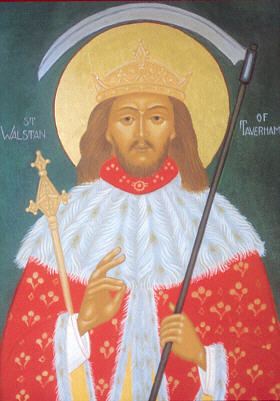Feast 30 May Name Walstan Walstan | Major shrine Bawburgh | |
 | ||
Patronage farms, farmers, farmhands, ranchers and husbandrymen Died 1016, Taverham, United Kingdom | ||
St Mary & St Walstan In Bawburgh
Saint Walstan (or Walston) (died 1016) was born either in Bawburgh in Norfolk, or Blythburgh in Suffolk, and because of a life dedicated to farming and the care of farm animals, is the patron saint of farms, farmers, farmhands, ranchers and husbandrymen.
Contents

Life
According to the hagiographer Alban Butler, Walstan was born in Bawburgh to a wealthy family. His parents were Benedict and Blida. An anonymous Lambeth Life in Lambeth Palace library gives his birthplace as "Blyborow town" or Blythburgh.
Walstan's mother, Saint Blitha of Martham, was a kinswoman of Æthelred the Unready and his son Edmund Ironside. Following her death and burial at Martham, a chapel was dedicated in her honour. Bequests were made to her for over four hundred years.
When he was twelve he left his parents' home and travelled to Taverham in Norfolk, where he worked as a farm labourer. He applied himself to the meanest and most painful labour in a perfect spirit of penance and humility, he fasted and spent periods of time in fervent prayer. He made a vow of celibacy, but never became a monk.
He died on 30 May 1016 at work in a meadow, after seeing a vision of an angel while at work scything a hay crop. His body was laid on a cart pulled by two white oxen as he had instructed and the cortege ended up at Bawburgh, where he was buried. At the three points along the journey that the oxen stopped, a spring arose. The well at Bawburgh can still be seen.
Veneration
By popular demand, he was declared a saint and a small chapel was built off the existing church of St Mary, giving it a new dedication of St Mary and St Walstan. He is honoured as a special saint of farm workers, farmers and farm animals.
Throughout the days of medieval pilgrimage, his shrine was sought by pilgrims from far and wide as well as local farmers and farm labourers.
St Walstan is represented in religious art by a crown and sceptre (generic emblems) and with a scythe in his hand and cattle near him (specific emblems). Icons dating from before the English Reformation are found mostly in Norfolk and Suffolk, but in modern times his cult has extended to Buckinghamshire, Kent and - amazingly - to Rongai in Kenya, where a church was dedicated to him in 1988.
St Walstan's Day is celebrated each year in Bawburgh, when a special Patronal Service takes place on the nearest Sunday to 30 May, his feastdate.
